
WOULD you believe…that the last time I did an extended post on 8th Avenue in Manhattan was…in 2007? It’s true. In fact quite a bit of what I showed on that page, set in Hell’s Kitchen, is gone now in 2021. For this week’s longform I need something of a shortform as I need to get my quota of exercise now that I work at home all week and don’t have time for midweek jaunts. I also need to take some time to study some things for the new job, with publisher Marquis Who’s Who.
So this week will be a “quickie” of sorts. I recently took a walk south from Penn Station on 8th Avenue, which runs into Hudson Street and took that south to the “Oculus” at the World Trade Center. I’ll concentrate on 8th Avenue today, and follow up with Hudson Street in a future post.
I’ll begin at a place in hope to never wind up.
No, I haven’t been inside the Hotel Vigilant, #370 8th Avenue between West 28th and West 29th. It’s a part of town I’m quite familiar with, though. For a few years in the late 1980s and the early 1990s I worked in a back office in a dark little building, #130 West 29th, for a type shop run by two Russian immigrant brothers and their associate, also from Russia, checking all their non-Cyrillic proofs for mistakes, which meant I would read material in French, Spanish, German and even Rhaeto-Romansch (sometimes called Swiss) character by character. The shop also had the Circus Magazine account: they were all pop metal then, so I would be looking over the adventures of Bret Michaels and Axl Rose while finding out who’s “ringing up” a birthday in the Lou O’Neill columns.
A few years later, I was writing catalog copy for Macy’s, and in between getting screamed at by the hatchet-faced supervisor, I’d be slumping around with a camera on my lunch hour. Though sometimes I’d take the subway south to the Village or north to Central Park (gathering images eventually used in the ForgottenBook), I’d mostly stay the f!@# away from 8th Avenue, since it still carried a not insubstantial whiff of the Old Bad Days, before Sheriff Rudy cleaned up the town. I suppose I should have hung out more on 8th Avenue because most of the seediness has been leached away, continuing in the Bloomberg and de Blasio eras.
But no, I haven’t been in the Hotel Vigilant. It’s a reminder of the old Bowery over on the east side, before it was transmogrified and be-glitzed as the magic wand of development tuned it into a boulevard of high-rises and restaurants. The subways, for all their improvement, are still hellish on occasion, and it all has to do with a certain way of thinking by those in charge of running things: “You take the subways for a reason, and you take limos for another reason.” If you’re down, you must deserve to be.
The Vigilant is a survivor of a mini-hotel row on 8th Avenue in the nebulous area south of Penn Station (built in 1910) and north of Chelsea. The Hotel Vigilant was apparently built in 1916 and by 1932, rooms were offered for 32¢ a night. By 2012 the price was up to $40 per night, or the bargain price of $140 per week. However, only Y-chromosomed are permitted lodgings.
The Vigilant is a fleabag in the truest sense of the word, and could also be called a bedbug-bag, as the bloodsucking Arthropoda crawl all over the five-story Italianate brick building. However, in an amenity few hostels provide, nontoxic bug spray is readily available, and by the most prominent account, it’s definitely needed. Rest rooms and showers are shared, and smoking is permitted in the rooms, which are 8x8x4 feet and are divided from other rooms by slight wooden slats. There is one lamp per ‘cubicle’, a wooden plank for a shelf, and an electric outlet.
Almost illegible by now, you can find a painted sign on the hotel facing north. The words “Vigilant Hotel” are just barely legible on the top.
More readable is the taped up sign above the entrance.
Piped of, but, three befouled showers, a pair of sinks, and toilettes of excreta. Succinctly, an inn of cells petit rented to gents of varied feather—all poor for whatever reason, breathing the airs of next step below homelessness. $125 per seven days. No credit, no checks, no euros, cartons maybe—of Marlboros. Never gleeful, rarely tended proud asylum sans musique. Fine abode for a bit of drifting or a brief disappearance. In sum, perfect for the bored with responsibilities of maintaining a traceable address. Foam pad, gray, oft cavorted ‘pon by bloodsucking mites. [Not For Tourists; the link is deceased]
The Vigilant is where you wind up when your resources are exhausted and you have nowhere else to go. It’s a communal hostel: you, your hotel-mates, the manager, and the bedbugs.
In the big city, if you’re at the end of your rope, more important people than you think you deserve nothing better then the Hotel Vigilant. I hope I never get to that point. A cautionary vision.
No, I haven’t been to the Hotel Vigilant, but these people have…
A Night at the Vigilant [Business Insider]
Checking Out the Vigilant Hotel [EV Grieve]
Vigilant Hotel [Walter Grutchfield]
A few years ago, the view looking west on West 28th from 8th Avenue wouldn’t have included these Hudson Yards behemoths. West 26th and 28th are a couple of rare Manhattan east-west numbered streets that actually curve; they were rebuilt that way when the Penn South Houses were constructed. Penn South is a world away from the Vigilant Hotel, which is just across the street. The 2,820 units in ten 22-story buildings complex dates to 1962 when they were first called the Mutual Redevelopment Houses when they were sponsored b y the sponsored by the International Ladies’ Garment Workers Union (ILGWU) and first proposed in 1956, when “slum clearance” was the rage and the “towers in a park” concept by French designer/philosopher Le Corbusier was the dominant form in lower-to middle class housing. Penn South was definitely in the middle-class camp, a territory few developers tread today. that has changed over the years and rents are commensurate with the rest of decent Manhattan housing, i.e. you need to trade in hedge funds.
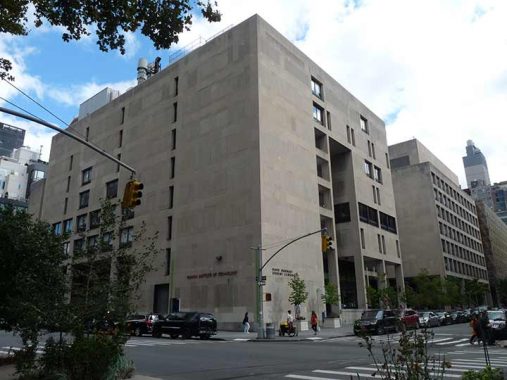
Fashion Institute of Technology (FIT) is a collegiate institute founded in 1944, associated with the State University of New York, offering a 4-year graduate program with special emphasis on the fashion industry; it’s located between West 26th and 28th between 7th and 8th Avenues, toward the south end of NYC’s Garment District. The Brutalist-style buildings [De Young & Moscowitz arch.], constructed in 1977, consist of the Fred Pomeranz Art and Design Center, David Dubinsky Student Center (shown here), a dormitory center named for ILGWU leader who helped found the American Labor Party and New York’s Liberal Party., and the Center for Design Innovation. The Museum at FIT is open to the public.
I chiefly remember FIT since one a week, on a lunch break from ANY Phototype on West 29th Street between 1988-1991, I would eat at a pizzeria across from the Dubinsky building and hang around afterward and girl watch. I was in my 20s.
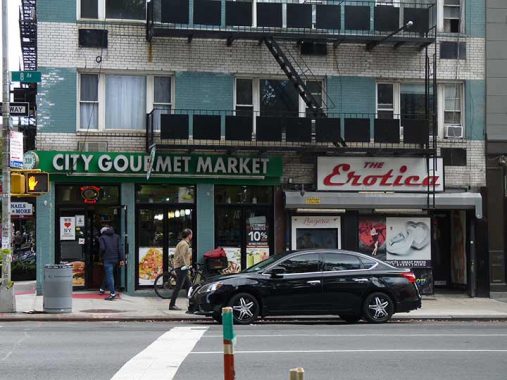
8th Avenue and the SE corner of East 27th. I have something of an affinity for the area; I recall there always being a porno place here, but not for that reason.
ANY Phototype was a job of little consequence, other than keeping me housed and in fish sticks and Birdseye. But in 1990, I heard about a school called Center For the Media Arts, housed in the former New York Auction Company building at #226 West 26th. There, I learned software like Adobe Photoshop and Illustrator as well as page composition software QuarkXpress. All confused me at first (like WordPress, which I use to make Forgotten NY) but there were generous lab hours and I sat in front of screens for hours, self-teaching.
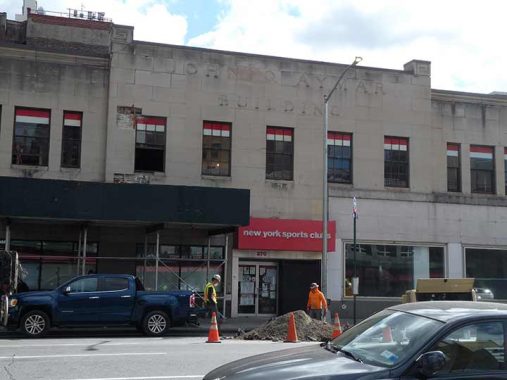
John Q. Aymar Building, 8th avenue and West 23rd Street.
I’ve passed by this building hundreds of times, as millions have, and plenty of times caught sight of the name “John Q Aymar” on the 8th Avenue side. I got around to looking him up, and it continues to be a puzzlement. The Aymars were a family of merchant princes in gaslight New York from the 1820s to the Civil War era, and more than one member was called John Q. Aymar. One of the JQAs is buried in Green-Wood Cemetery, and the Metropolitan Museum of Art owns a portrait of one of the JQA families painted in 1838.
Historian Joseph Ditta: According to an item in the New York Times of 8 August 1937, the building was named for John Q. Aymar, great-grandfather of Bradish G. and Aymar Johnson, trustees of the Aymar Johnson estate, who developed the property that John Q. had purchased back in 1839.
Thus, the name goes back a long way I had been wondering what that Q stands for. Maybe it stood for the same thing the Q in talk show host Robert Q. Lewis stood for: nothing. He just liked the Q.
Not really. It turns out his name was John Quereau Aymar.
Update: this building was torn down early 2022.
I despaired momentarily when I saw the rollgate shuttered at the Trailer Park Longe on West 23rd just east of 8th, but fear not, I was here before it opened. If you haven’t been there, the interior, seen here on the website, has to be seen to be believed because it’s chockablock with memorabilia from most decades of the 20th Century. As far as the menu is concerned, it’s all rich fried food that will kill you if you ate it every day. I was introduced to the place a few years ago at the after party for the annual Guides Association of New York Awards show (I won Best Website, the first ever awarded, in 2015; see the right sidebar). A lot of people attend that thing in tuxedos and gowns and there they were in the Trailer Park Lounge, which kept the margaritas and onion rings coming.
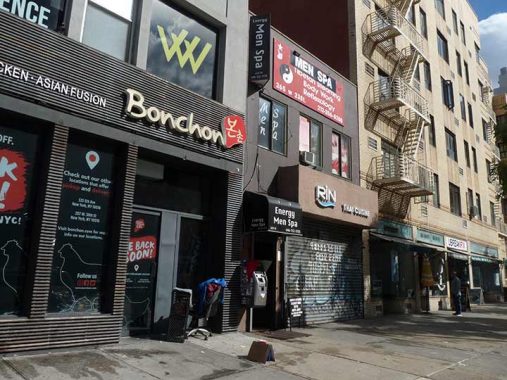
Why am I showing you these adjacent storefronts on West 23rd? I was frequently to be found in one of them when it was the home of Midnight Records, which specialized in the 1960s-era garage punk records which remain my favorite genre to this day. Midnight closed about 20 years ago but retained a mail order business for a number of years.
ears maybe, I staggered into one and was mistaken for Jack Casady of the Jefferson Airplane. These days, even though I work at home 100% of the time, I get regular haircuts so I’m not mistaken for Steve Bannon.
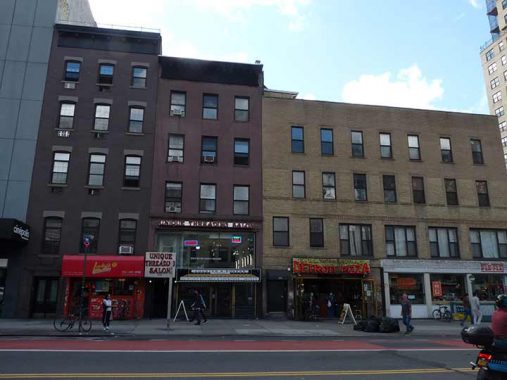
If you don’t mind a bit more nostalgia, either the Detroit Pizza place or the storefront to its left, south side of West 23rd near 8th was Burritoville 20 years ago, which had fast food tacos a cut above what they sell you at Taco Bell. It was a once per week staple when I worked at Macy’s about 11 blocks uptown. As for Detroit Pizza, their “squares” are more massive versions of the sauce on top, cheese on the bottom thick crusts you get at L&B Spumoni Gardens in Gravesend, and they sit in your stomach like a basketball a couple hours after you finish. Taste good, though.
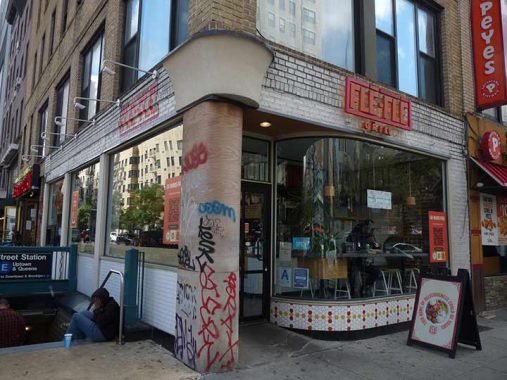
Flé-Flé Grill, SE corner of 8th and west 23rd, vends falafal and other Mideast-Mediterranean treats. One wishes they would swab off the graffiti, but maybe they like it that way. It’s in a choice spot next to the uptown 23rd Street C/E train.

The boutique Gem Hotel at the SW corner of 8th Avenue and West 22nd was for many years a welfare hotel/hovel called The Allerton. Poet/rocker Patti Smith and artist/photographer Robert Mapplethorpe stayed there in the 1970s, as recounted in Smith’s memoir.”Just Kids”:
These days marked the lowest point in our life together. I don’t remember how we found our way to the Allerton. It was a terrible place, dark and neglected, with dusty windows that overlooked the noisy street. . . . The springs of the ancient mattress poked through the stained sheet. The place reeked of piss and exterminator fluid, the wallpaper peeling like dead skin in summer. There was no running water in the corroded sink, only occasional rusted droplets plopping through the night . . . .
The place was filled with derelicts and junkies. I was no stranger to cheap hotels. . . . There was nothing romantic about this place, seeing half-naked guys trying to find a vein in limbs infested with sores. Everybody’s door was open because it was so hot, and I had to avert my eyes as I shuttled to and from the bathroom to rinse out cloths for Robert’s forehead. . . . His lumpy pillow was crawling with lice and they mingled with his damp matted curls.
The Allerton’s old plastic-lettered “Hotel” sign is still there, and the shell of its old neon sign is still there too.
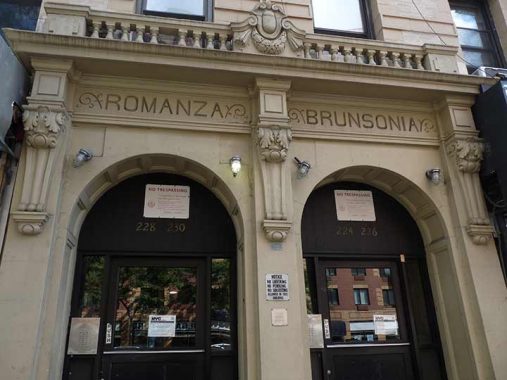
I suppose I will never really know the stories behind the names of the Brunsonia and Romanza apartment buildings at #224-#230 8th Avenue between West 21st and 22nd. Anyone want to guess?
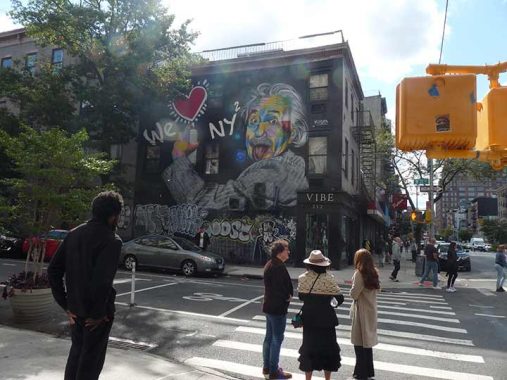
Probably the most famed image of Albert Einstein, the great German physicist who discovered that mass equals energy times the speed of light squared energy = mass times the speed of light squared, or mass = energy divided by the speed of light squared and proved the theory of relativity — basically the building blocks describing how the universe works — is Einstein playfully sticking his tongue out, photographed by Arthur Sasse in 1951.
The image appears on the side of 212 8th Avenue at West 21st, home to the Vibe lingerie store on the ground floor, formerly the Rawhide club. This is an early Eduardo Kobra, perhaps the finest muralist working in NYC today.
For the bulk of this page, I will be talking about sidewalk signage since 8th Avenue has some choice examples. The Lou Lou French bistro at the SE corner of 8th and West 19th (repetition seems to be a theme for restaurants on this stretch) has bedecked its exterior with flowers and has even decorated a lamppost and decommissioned fire alarm with the red, white and blue of the French flag (and coincidentally the American).


A little history about this location. The 1940 tax photo shows the Thomas Diner, a railroad car special, and one from the late 1990s shows the Sam Chinita (earlier “Mi Chinita”) “fusion” Chinese-Spanish restaurant, also in a diner, this one the same shape but with metal construction. It might have been a newer structure or updated one (Ron Saari, photo). A better photo, perhaps, is here.
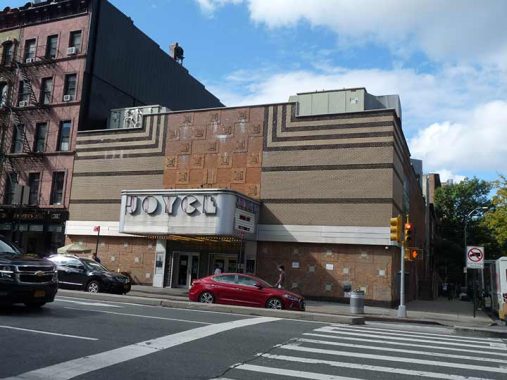
Directly across the street is the Joyce Theatre, a 472-seat dance performance venue opened in 1982 in the renovated and remodeled Elgin Theatre, opened in 1942, that had come on hard times in the 1970s as a porno palace — the renovation was supervised by architect Hugh Hardy, whose renovation work can be seen all over town. I’m not a ballet or modern dance fan, but I mention the theatre because it is named for one of the founders of one of my workplaces. Joyce Mertz-Gilmore along with her parents, Harold and LuEsther Mertz, founded Publishers Clearing House, the premier direct marketing company in the country, in their basement in Sands Point, NY, in 1953. The Joyce Theatre exists in great part due to the philanthropic efforts of LuEsther Mertz.
Next door to Lou Lou is cocktail bar Jungle Bird. I have begun to show some of the gutter restaurant dining sheds that I like. Some are junky indeed but there are some occasional gems. I especially like the ones that maintain the color scheme of the parent restaurant.
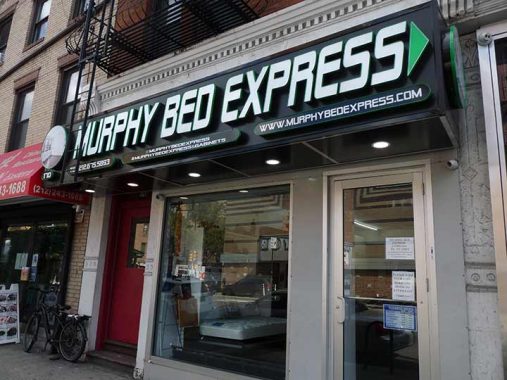
Two doors down is Murphy Bed Express. I was unaware that these beds, which tip up into closets or can trundle out from drawers, were still popular. They have been endless sources of screen comedy…and James Bond movies
According to Smithsonian Magazine, the Murphy Bed was originally invented around 1900 in San Francisco, when William Lawrence Murphy “was falling for a young opera singer and courting customs at that time would not permit a lady to enter a gentleman’s bedroom. His invention allowed him to stow his bed in his closet, transforming his one-room apartment from a bedroom into a parlor.” [Smartspaces]
I found two of these odd food & sex two-floor combos on 8th Avenue 11 blocks apart, On West 19th and West 30th. 8th Avenue was the home of Show World, The Playpen and other raunch houses during the heyday of sleaze in the 1970s-1990s and you still see some of it poking through today.
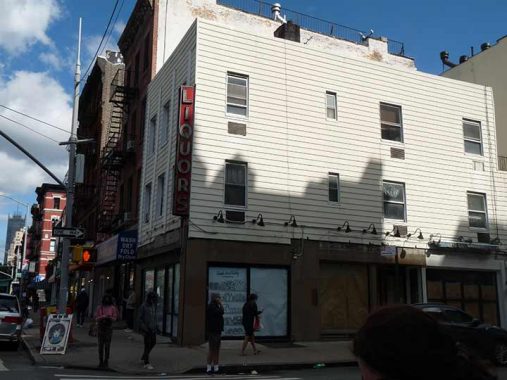
Its corner liquor store sign at #162 8th Avenue is still there but there hasn’t been one here since Home of Cheers left the premises in late 2013 or early 2014. The neon on the West 18th Street side was even more impressive.
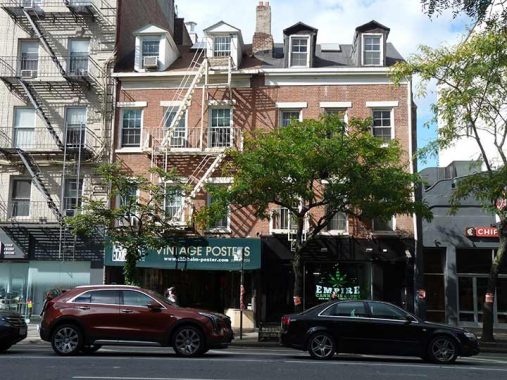
Though this particular section of Chelsea isn’t landmarked, these two buildings at #145 and 147 near West 17th are. This section of Chelsea, in the postcolonial era, was owned by George Rapelje, who operated a farm. The Clement Clarke Moore holdings were just to the north and the most obvious relic of that time is the General Theological Seminary of the Episcopal Church grounds between 9th and 10th Avenues at West 20th Street.
8th Avenue was built in Chelsea in 1816, just 5 years after the “Commissioners’ Plan” for the Manhattan street grid was enacted and about a decade after John Randel surveyed the area on horseback. It took nearly a decade but Rapelye finally sold the property in the mid-1820s, with these two houses developed by Steven Weeks and Aaron Dexter in 1827 and 1828. From 1850-1870 #145 was the site of a popular photo studio. Tom Miller, the Daytonian in Manhattan, has the complete story.
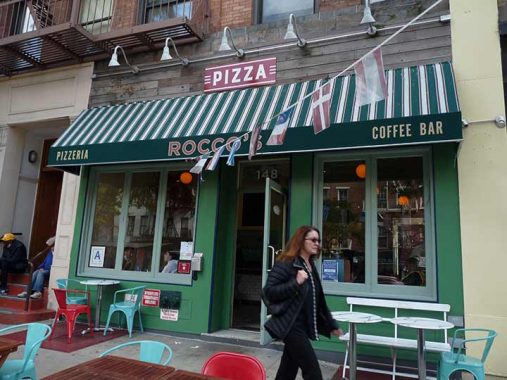
Not much to say about Rocco’s Pizza at #148 8th Avenue but I enjoy the straightforward presentation, sanserif lettering, awning and red, green and white color scheme you often find with Italian-themed businesses.
#111 8th Avenue is one of the few NYC buildings that take up an entire square block: between 8th and 9th Avenue and West 15th and 16th Streets. It’s an Art Moderne classic constructed in 1932 and designed by Lusby Simpson of Abbott, Merkt & Co. as the Port Authority Commerce Building. It was a multi-use building designed to be used as a trucking terminal and also to handle exhibitions and manufacturing.
At its peak in the 1930s the Port Authority serviced 8000 tons of goods in the building and as many as 650 trucks passed into the building daily. The building has 15 floors the size of football fields.
As less shipping took place on the Manhattan side of the Hudson River the building lessened in importance, but it did serve as Port Authority headquarters from 1947 to 1980. For about a decade beginning in 1998 Taconic Investment Partners owned the building and used it as a data center during the internet boom.
In 2010 the building was acquired by internet giant Google, which installed large white logos on the 8th and 9th Avenue sides. However, Art Deco details in gold finish at the building’s entrances have remained intact. I once attended an Adsense seminar at the Google HQ here but left midway through, as the jargon confused me.

Pad Thai Lounge, at #114 8th Avenue across from the Port Authority building, has a secret. Pad thai is a generic term for a popular food in Thailand consisting of stir-fried rice noodles, egg, bean sprouts, shrimp, peanuts, and seasonings; the name comes from the Thai term phad thaj, roughly “fried dish from Thailand.” It is also the name of a restaurant, Pad Thai Lounge, at 114 8th Avenue just off West 16th Street in Chelsea. I passed the restaurant during routine perambulations, and noticed that the proprietor has preserved something on the sidewalk sign, a much older sign from a previous tenant with a generic sign designating it as a lounge/restaurant. Dating the sign is difficult…
…because it employs a “privilege sign” (in which a sign was sponsored by an advertiser) that used the main 7 Up logo that was in use between 1943 and 1972, the longest-lived logo the lemon-lime soda has ever employed, and frankly, it’s the best; none before or since have been this iconic. Thus, the sign could have been installed during any year from 1943 to 1972, a good 29 years. (I’m not wrong: the gap from 1943 to 1972 was infinitely longer, temperamentally, than between 1972 and 2001.)
The Bib-Label Lithiated Lemon-Lime Soda was originated in 1929 by Charles Leiper Grigg, but that name was of course too unwieldy and 7 Up was adopted in 1936. Theories abound about the name; some speculate that seven main ingredients are used, and others say that “7” is the atomic mass of lithium citrate, which was used in the drink’s production until 1948. Lithium’s mood-altering nature is well-known and has been used in psychological treatments. 7 Up was originally marketed in 7-ounce bottles, which is likely the true reason.
I do not know if you can get 7 Up with your pad thai at the Pad Thai Lounge.
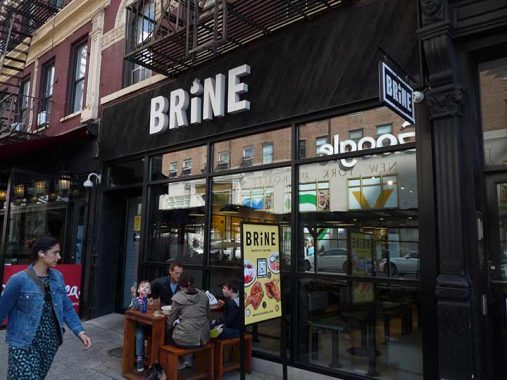
When I was a kid, I read that pitcher Nolan Ryan would get nasty blisters on his fingers from throwing the ball so hard. All pitchers throw hard, but some are more susceptible than others to blisters. Ryan would soak his pitching hand in pickle brine to toughen his skin, and enjoyed a 25 year major league career.
Brining food is simpler; food is soaked in salt water before preparation. This chicken restaurant at #106 8th combines brining with a secret sauce recipe. Hey, I’d try it. I liked the presentation of raised white letters on a dark background.

A couple of years ago the Department of Transportation banned private cars and trucks from 14th Street, except for local residents and deliveries, and turned over the entire street to buses. The “bigloop” streetlamps are only found here.
what was originally the New York County National Bank (ghost letters can still be seen on the pediment), from 1907 by architects DeLemos and Cordes with Rudolph Daus. (DeLemos and Cordes also designed other monumental buildings like the Siegel Cooper Dry Goods Store on 6th Avenue and West 18th and Macy’s in Herald Square)
After a stint as Manufacturers Trust– later Manufacturers Hanover Bank the building became a theater and is now the Museum of Illusions
This copper domed, Corinthian-columned building on the NW corner of 8th Avenue and West 14th Street is the former New York Bank For Savings, constructed in 1897 by architect Robert Henderson Robertson. It passed through incarnations as Goldome Bank, Central Carpet, Balducci’s, and most the fanciest CVS drugstore in NYC. The Classic Revival bank resembles its contemporary, the Bowery Savings Bank in Chinatown. The former bank was restored in the 1980s by Robert Scarano Jr. Note the white marble exterior and the stained glass windows surrounding the dome. The copper clock features renderings of bees and beehives, a traditional symbol of thrift.
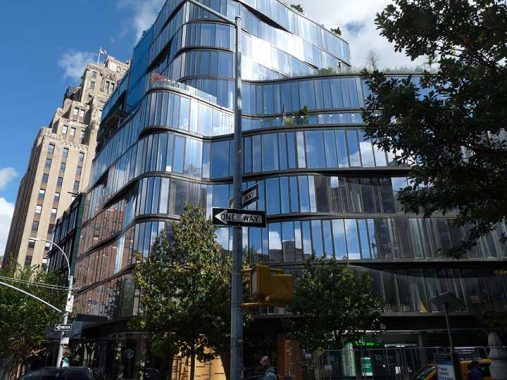
I disliked the glassy, undulating One Jackson Square at 8th and Greenwich Avenues when it arrived in 2009-2010 because it hides a very large ancient painted ad, but I have had a1 grudging appreciation; it’s more imaginative than what I’ve seen in new buildings since.
Located on the triangle between 8th and Greenwich Avenues and Horatio Street, Jackson Square has officially been a public park since 1872, though it appears as a “square” on maps prior to that. It’s widely thought that the square is named for its most obvious honoree, President Andrew Jackson ( 1767-1845) since “Old Hickory” had been a hero in Tammany Hall circles. However, Mozart Hall, a faction that had split off from Tammany, met in a building called Jackson Hall at #2 Horatio across the street from the park. Mozart Hall founder Fernando Wood was elected mayor of NYC in 1859 after winning from Tammany in 1854. The large iron fountain was added as part of renovations that took place in 1990.
New to Jackson Square, or at least new to me, are a pair of exhibits resembling Joseph Cornell’s “shadow boxes” that depict two of the more disparate authors imaginable, James Baldwin (“Notes of a Native Son” and “The Fire Next Time”) and Oliver Sacks, who related odd neurological maladies in “The Man Who Mistook His Wife For a Hat.”

I’m not a liquor connoisseur, but I am a neon sign connoisseur and Manley’s has a terrific one at #35 8th Avenue and Jane. Have a look inside.
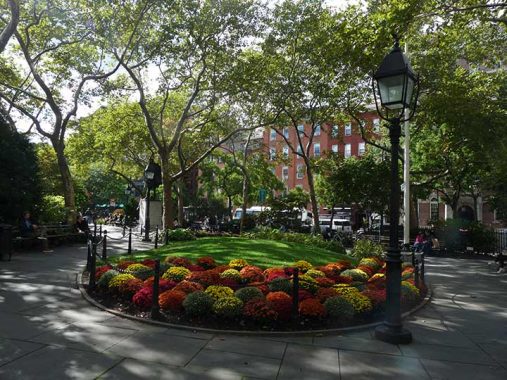
I’m not sure when 8th Avenue was extended south of Greenwich Avenue to Hudson Street at Bethune, but it shows up like that on maps as far back as the 1840s, so it’s been a long time. The south end of 8th Avenue is punctuated by Abingdon Square.
The square is named for the Earl of Abingdon, the son-in- law of Sir Peter Warren, a Royal Navy officer who owned much of the territory in the Village before the Revolutionary War, including the triangle of property now occupied by the square. The square’s statue, dedicated in 1921 for its centennial, was sculpted by Philip Martiny. A former major east-west road in lower Manhattan, predating the grid, was called Abingdon Road.
The statue depicts a World War I “doughboy,” as do many WWI memorial statues around town do, and was a gift from the Jefferson Democratic Club. Martiny sculpted a second such memorial nearby at 9th Avenue and West 28th Street that used the same model!
As always, “comment…as you see fit.” I earn a small payment when you click on any ad on the site.
11/8/21

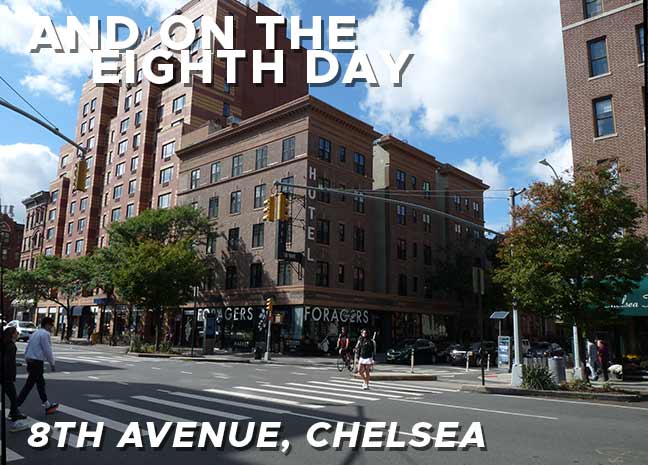

10 comments
A correction and an update are in order:
“Penn South” (still formally known as “Mutual Redevelopment Houses”) is not ten 22 story buildings, but, rather, fifteen 21 story buildings (Ten of these buildings are attached by single entrances for two adjoining buildings). The complex’s green spaces are among the largest south of Central Park in Manhattan.
Update: The Aymar building is currently vacant and about to be torn down to make way for an 11-story building that will include a Target on the corner.
@Steve K I live in Penn South, the buildings are actually 22 stories tall but the first floor lobby isn’t counted, thus you have the “1st” floor units actually being on the second floor of the building. Not sure why it’s like this and as it tends to cause confusion for delivery people and guests who press “1st floor” expecting to exit the building and end up lost in the wrong floor haha
The Penn South buildings are clearly precursors of the Warbasse buildings at Ocean Pkwy and Neptune Ave
in Coney Island. Not surprising, since ILGWU also was behind that project, too.
In the mid ’70s, Lane Limited, makers of Medal of Honor cigars and pipe tobacco and Ben Wade and Charatan pipes, moved from its location at 419 Park Ave. South to the 7th and 8th floors at 111 8th Ave. My father worked for Herman G. Lane as a mater blender.
That’s master blender.
What do expensive fancy-pants luxury hotels have in common with the Vigilant and the now-departed Allerton? Bedbugs.
The reference to Robert Mapplethorpe brings back a memory. Back when I was still in Connecticut a girl I was dating and I went to an exhibit of his photographs at the Wadsworth Athaneum in Hartford. We were in a crowded room, full of people standing around all looking Serious, when we spotted two adjacent photos that were so absurdly, unspeakably pornographic that we started to laugh. While at first we tried to stifle out laughter the scolding looks we got from the Serious people in the room of course only made us laugh even harder. We made a quick exit from the room, convulsed in laughter.
My dad owned a drug store at 218 8 Ave. near 21 St. from the late 60’s until he closed it in the 80s. It was called George Bruns Pharmacy named after the German immigrant who founded it in 1848. My dad bought the business from a descendant, also named George Bruns. This may have some connection with the “Brunsonia” building down the block that is in your photos. You can view the store in the old tax photos online. Two doors away was Bright Coffee Shop, a greasy spoon sort of place with friendly service and great coffee. The business is (I believe) still there in a different incarnation with the original multi-colored neon sign still present. I used to eat at Sam Chinita / Mi Chinita many times. It was a steel diner building that is now gone. There were many such places at the time owned by Cubans of Chinese descent who escaped to the USA when Castro took over Cuba. Back in the 60s-70s, Chelsea was not the affluent community that it is now. It was populated with many European and Latin American immigrants. There were also a few Broadway people who sought out inexpensive housing close to the Theater District.
actually Einstein’s formula is that energy = mass times the speed of light squared, or mass = energy divided by the speed of light squared (but great page nonetheless!)
I wonder what Le Corbusier’s own house looked like
I lived in the Chelsea area from early 1950 until the mid 1970’s and witnessed many changes. I recall the area where PENN SOUTH is situated, before, during, and after it’s construction. I went to parochial school on W24th Street in the middle of all the construction. In or about 1961, my self and a couple of friends had a Hot Dog cookout behind the Greek Church on W24th Street using wood found from apartment buildings demolished to make way for PENN South to be built. By the way, 24th & 28th Street are the two city East West streets that bulge South and North mid block in the PENN South complex. W26th Street is straight as an arrow between 8th & 9th Avenues. The Aymar Building once hosted a Bowling Alley on the Second floor, a Lampston’s Five & Dime store on street level, along with a drug store on the corner of 8th Avenue & W23rd Street. The Aymar building was opposite across 8th Avenue from the old Grand RKO movie theater it was razed and moved mid block on W23rd street where a row of stores are today built during Penn South development.